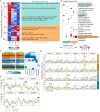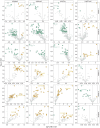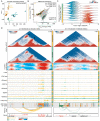An Atlas of Promoter Chromatin Modifications and HiChIP Regulatory Interactions in Human Subcutaneous Adipose-Derived Stem Cells
- PMID: 38203607
- PMCID: PMC10778978
- DOI: 10.3390/ijms25010437
An Atlas of Promoter Chromatin Modifications and HiChIP Regulatory Interactions in Human Subcutaneous Adipose-Derived Stem Cells
Abstract
The genome of human adipose-derived stem cells (ADSCs) from abdominal and gluteofemoral adipose tissue depots are maintained in depot-specific stable epigenetic conformations that influence cell-autonomous gene expression patterns and drive unique depot-specific functions. The traditional approach to explore tissue-specific transcriptional regulation has been to correlate differential gene expression to the nearest-neighbor linear-distance regulatory region defined by associated chromatin features including open chromatin status, histone modifications, and DNA methylation. This has provided important information; nonetheless, the approach is limited because of the known organization of eukaryotic chromatin into a topologically constrained three-dimensional network. This network positions distal regulatory elements in spatial proximity with gene promoters which are not predictable based on linear genomic distance. In this work, we capture long-range chromatin interactions using HiChIP to identify remote genomic regions that influence the differential regulation of depot-specific genes in ADSCs isolated from different adipose depots. By integrating these data with RNA-seq results and histone modifications identified by ChIP-seq, we uncovered distal regulatory elements that influence depot-specific gene expression in ADSCs. Interestingly, a subset of the HiChIP-defined chromatin loops also provide previously unknown connections between waist-to-hip ratio GWAS variants with genes that are known to significantly influence ADSC differentiation and adipocyte function.
Keywords: 3D organization; adipose tissue; adipose-derived stem cell; chromatin; epigenome; transcriptome.
Conflict of interest statement
Authors Adeline Divoux and Steven R. Smith are employed by the company AdventHealth. The remaining authors declare that the research was conducted in the absence of any commercial or financial relationships that could be construed as a potential conflict of interest.
Figures





Similar articles
-
Differential open chromatin profile and transcriptomic signature define depot-specific human subcutaneous preadipocytes: primary outcomes.Clin Epigenetics. 2018 Nov 26;10(1):148. doi: 10.1186/s13148-018-0582-0. Clin Epigenetics. 2018. PMID: 30477572 Free PMC article. Clinical Trial.
-
Chromatin accessibility and gene expression during adipocyte differentiation identify context-dependent effects at cardiometabolic GWAS loci.PLoS Genet. 2021 Oct 26;17(10):e1009865. doi: 10.1371/journal.pgen.1009865. eCollection 2021 Oct. PLoS Genet. 2021. PMID: 34699533 Free PMC article.
-
Distinct subpopulations of human subcutaneous adipose tissue precursor cells revealed by single-cell RNA sequencing.Am J Physiol Cell Physiol. 2024 Apr 1;326(4):C1248-C1261. doi: 10.1152/ajpcell.00726.2023. Epub 2024 Mar 4. Am J Physiol Cell Physiol. 2024. PMID: 38581663 Free PMC article.
-
Epigenomics in stress tolerance of plants under the climate change.Mol Biol Rep. 2023 Jul;50(7):6201-6216. doi: 10.1007/s11033-023-08539-6. Epub 2023 Jun 9. Mol Biol Rep. 2023. PMID: 37294468 Review.
-
Hooked Up from a Distance: Charting Genome-Wide Long-Range Interaction Maps in Neural Cells Chromatin to Identify Novel Candidate Genes for Neurodevelopmental Disorders.Int J Mol Sci. 2023 Jan 6;24(2):1164. doi: 10.3390/ijms24021164. Int J Mol Sci. 2023. PMID: 36674677 Free PMC article. Review.
Cited by
-
Fish oil attenuates the expression of the CCL2 chemokine and histone-modifying enzymes in LPS-stimulated human preadipocytes.Metabol Open. 2024 Nov 30;24:100336. doi: 10.1016/j.metop.2024.100336. eCollection 2024 Dec. Metabol Open. 2024. PMID: 39717736 Free PMC article.
-
Osteopontin derived from hypoxia-induced M2 macrophages promotes osteosarcoma progression through modulation of EGR3/ISG15 signaling and RIG-I expression.J Transl Med. 2025 Aug 21;23(1):950. doi: 10.1186/s12967-025-06936-y. J Transl Med. 2025. PMID: 40841904 Free PMC article.
-
Effects of obesity-associated plasma markers on adipose stem cell function and epigenetic regulation.Obesity (Silver Spring). 2025 Aug;33(8):1529-1542. doi: 10.1002/oby.24321. Epub 2025 Jun 16. Obesity (Silver Spring). 2025. PMID: 40518865 Free PMC article.
References
-
- Canoy D., Boekholdt S.M., Wareham N., Luben R., Welch A., Bingham S., Buchan I., Day N., Khaw K.T. Body fat distribution and risk of coronary heart disease in men and women in the European Prospective Investigation Into Cancer and Nutrition in Norfolk cohort: A population-based prospective study. Circulation. 2007;116:2933–2943. doi: 10.1161/CIRCULATIONAHA.106.673756. - DOI - PubMed
MeSH terms
Substances
Grants and funding
LinkOut - more resources
Full Text Sources

